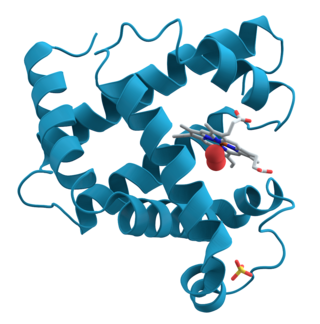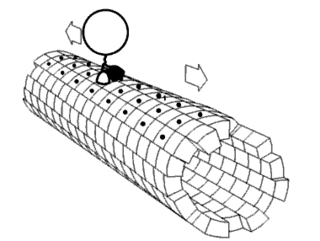
Structural biology, as defined by the Journal of Structural Biology, deals with structural analysis of living material at every level of organization.

Biophysics is an interdisciplinary science that applies approaches and methods traditionally used in physics to study biological phenomena. Biophysics covers all scales of biological organization, from molecular to organismic and populations. Biophysical research shares significant overlap with biochemistry, molecular biology, physical chemistry, physiology, nanotechnology, bioengineering, computational biology, biomechanics, developmental biology and systems biology.
Chemical physics is a branch of physics that studies chemical processes from a physical point of view. It focuses on understanding the physical properties and behavior of chemical systems, using principles from both physics and chemistry. This field investigates physicochemical phenomena using techniques from atomic and molecular physics and condensed matter physics.

The Max Planck Institute of Biochemistry is a research institute of the Max Planck Society located in Martinsried, a suburb of Munich. The institute was founded in 1973 by the merger of three formerly independent institutes: the Max Planck Institute of Biochemistry, the Max Planck Institute of Protein and Leather Research, and the Max Planck Institute of Cell Chemistry.

The Max Planck Institute for Biophysical Chemistry, also known as the Karl-Friedrich Bonhoeffer Institute, was a research institute of the Max Planck Society, located in Göttingen, Germany. On January 1, 2022, the institute merged with the Max Planck Institute for Experimental Medicine in Göttingen to form the Max Planck Institute for Multidisciplinary Sciences.

The Journal of Physical Chemistry A is a scientific journal which reports research on the chemistry of molecules - including their dynamics, spectroscopy, kinetics, structure, bonding, and quantum chemistry. It is published weekly by the American Chemical Society.
X-PLOR is a computer software package for computational structural biology originally developed by Axel T. Brunger at Yale University. It was first published in 1987 as an offshoot of CHARMM - a similar program that ran on supercomputers made by Cray Inc. It is used in the fields of X-ray crystallography and nuclear magnetic resonance spectroscopy of proteins (NMR) analysis.
The Journal of Physics B: Atomic, Molecular and Optical Physics is a biweekly peer-reviewed scientific journal published by IOP Publishing. It was established in 1968 from the division of the earlier title, Proceedings of the Physical Society. In 2006, the Journal of Optics B: Quantum and Semiclassical Optics was merged with the Journal of Physics B. The editor-in-chief is Marc Vrakking.
Herbert Sander Gutowsky was an American chemist who was a professor of chemistry at the University of Illinois Urbana-Champaign. Gutowsky was the first to apply nuclear magnetic resonance (NMR) methods to the field of chemistry. He used nuclear magnetic resonance spectroscopy to determine the structure of molecules. His pioneering work developed experimental control of NMR as a scientific instrument, connected experimental observations with theoretical models, and made NMR one of the most effective analytical tools for analysis of molecular structure and dynamics in liquids, solids, and gases, used in chemical and medical research, His work was relevant to the solving of problems in chemistry, biochemistry, and materials science, and has influenced many of the subfields of more recent NMR spectroscopy.
Edgar Bright Wilson Jr. was an American chemist.

Sir Alan Walsh FAA FRS was a British-Australian physicist, originator and developer of a method of chemical analysis called atomic absorption spectroscopy.

Molecular models of DNA structures are representations of the molecular geometry and topology of deoxyribonucleic acid (DNA) molecules using one of several means, with the aim of simplifying and presenting the essential, physical and chemical, properties of DNA molecular structures either in vivo or in vitro. These representations include closely packed spheres made of plastic, metal wires for skeletal models, graphic computations and animations by computers, artistic rendering. Computer molecular models also allow animations and molecular dynamics simulations that are very important for understanding how DNA functions in vivo.

The Journal of Chemical Crystallography is a peer-reviewed scientific journal publishing original (primary) research and review articles on crystallography and spectroscopy. It is published monthly by Springer Science+Business Media.
The following outline is provided as an overview of and topical guide to biophysics:

The International Journal of Biological Macromolecules is a peer-reviewed scientific journal covering research into chemical and biological aspects of all natural macromolecules. It publishes articles on the molecular structure of proteins, macromolecular carbohydrates, lignins, biological poly-acids, and nucleic acids. It also includes biological activities and interactions, molecular associations, chemical and biological modifications, and functional properties as well as development of related model systems, structural including conformational studies, new analytical techniques, and relevant theoretical developments.

The B. Verkin Institute for Low Temperature Physics and Engineering of the National Academy of Sciences of Ukraine is a research institute that conducts basic research in experimental and theoretical physics, mathematics, as well as in the field of applied physics. It was founded in 1960 by Borys Verkin, Oleksandr Galkin, Borys. Eselson and Ihor Dmytrenko. The first director was Borys Verkin.

G. Marius Clore MAE, FRSC, FMedSci, FRS is a British-born, Anglo-American molecular biophysicist and structural biologist. He was born in London, U.K. and is a dual U.S./U.K. Citizen. He is a Member of the National Academy of Sciences, a Fellow of the Royal Society, a Fellow of the Academy of Medical Sciences, a Fellow of the American Academy of Arts and Sciences, a NIH Distinguished Investigator, and the Chief of the Molecular and Structural Biophysics Section in the Laboratory of Chemical Physics of the National Institute of Diabetes and Digestive and Kidney Diseases at the U.S. National Institutes of Health. He is known for his foundational work in three-dimensional protein and nucleic acid structure determination by biomolecular NMR spectroscopy, for advancing experimental approaches to the study of large macromolecules and their complexes by NMR, and for developing NMR-based methods to study rare conformational states in protein-nucleic acid and protein-protein recognition. Clore's discovery of previously undetectable, functionally significant, rare transient states of macromolecules has yielded fundamental new insights into the mechanisms of important biological processes, and in particular the significance of weak interactions and the mechanisms whereby the opposing constraints of speed and specificity are optimized. Further, Clore's work opens up a new era of pharmacology and drug design as it is now possible to target structures and conformations that have been heretofore unseen.
Marc Baldus is a physicist and professor of NMR spectroscopy at Utrecht University. He is especially known for his work in the field of structural biology using solid-state nuclear magnetic resonance (ssNMR) spectroscopy. He applies ssNMR methods to establish structure-function relationships in complex biomolecular systems including membrane and Amyloid proteins. In addition, he develops cellular NMR methods to study large molecular transport and insertion systems in bacteria as well as signal transduction mechanisms in eukaryotic cells.

Svyatoslav Petrovich Gabuda was a Soviet/Russian physicist, professor, and doctor of physical and mathematical sciences.
Structural chemistry is a part of chemistry and deals with spatial structures of molecules and solids. For structure elucidation a range of different methods is used. One has to distinguish between methods that elucidate solely the connectivity between atoms (constitution) and such that provide precise three dimensional information such as atom coordinates, bond lengths and angles and torsional angles.












